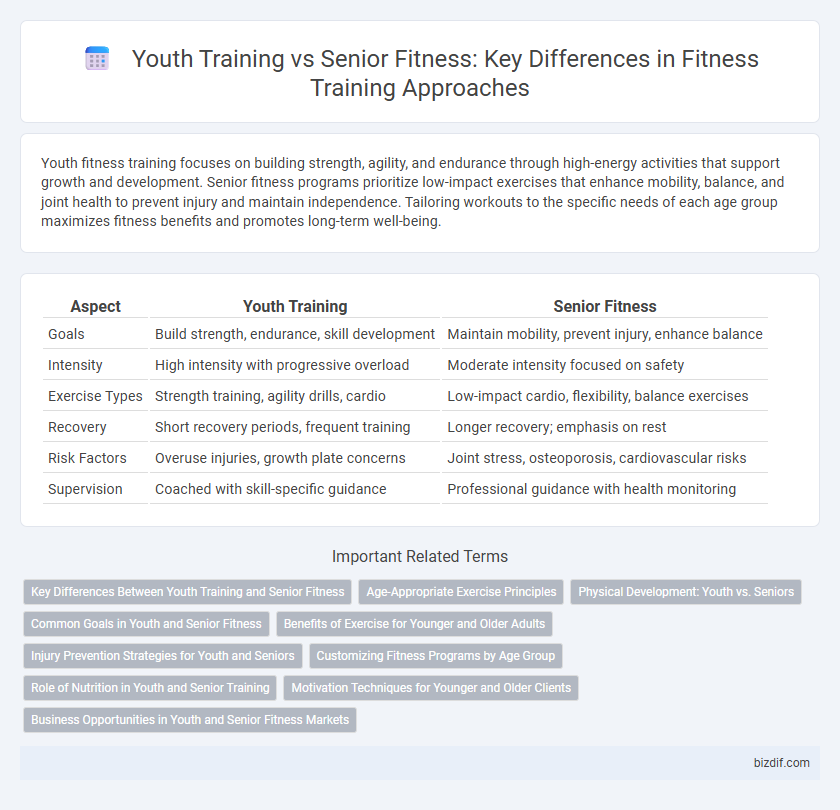Youth fitness training focuses on building strength, agility, and endurance through high-energy activities that support growth and development. Senior fitness programs prioritize low-impact exercises that enhance mobility, balance, and joint health to prevent injury and maintain independence. Tailoring workouts to the specific needs of each age group maximizes fitness benefits and promotes long-term well-being.
Table of Comparison
| Aspect | Youth Training | Senior Fitness |
|---|---|---|
| Goals | Build strength, endurance, skill development | Maintain mobility, prevent injury, enhance balance |
| Intensity | High intensity with progressive overload | Moderate intensity focused on safety |
| Exercise Types | Strength training, agility drills, cardio | Low-impact cardio, flexibility, balance exercises |
| Recovery | Short recovery periods, frequent training | Longer recovery; emphasis on rest |
| Risk Factors | Overuse injuries, growth plate concerns | Joint stress, osteoporosis, cardiovascular risks |
| Supervision | Coached with skill-specific guidance | Professional guidance with health monitoring |
Key Differences Between Youth Training and Senior Fitness
Youth training emphasizes rapid muscle development, cardiovascular endurance, and coordination through high-intensity, dynamic exercises tailored to growth spurts and motor skill enhancement. Senior fitness prioritizes joint mobility, balance, low-impact strength training, and fall prevention to maintain functional independence and reduce age-related muscle loss (sarcopenia). Training intensity, recovery time, and exercise selection are carefully adjusted to accommodate physiological differences and risk factors unique to each age group.
Age-Appropriate Exercise Principles
Youth training emphasizes developing fundamental movement skills, flexibility, and muscular endurance tailored to rapid growth phases, prioritizing low-impact exercises to prevent injury. Senior fitness focuses on maintaining mobility, strength, and balance through moderate-intensity aerobic activities and resistance training adjusted for joint health and chronic conditions. Age-appropriate exercise principles ensure customized intensity, volume, and recovery periods optimize physical development and minimize risks across different life stages.
Physical Development: Youth vs. Seniors
Youth training emphasizes building foundational strength, motor skills, and cardiovascular endurance to support rapid physical growth and development. Senior fitness focuses on maintaining muscle mass, joint mobility, and bone density to prevent age-related decline and enhance functional independence. Tailoring workouts to developmental needs ensures effective and safe progress for both age groups.
Common Goals in Youth and Senior Fitness
Youth training and senior fitness programs both aim to improve strength, flexibility, and cardiovascular health to enhance overall well-being. Emphasizing injury prevention and functional movement is crucial across age groups to maintain mobility and independence. Customized training intensity and recovery times address the physiological differences while supporting shared goals like improving endurance and promoting lifelong healthy habits.
Benefits of Exercise for Younger and Older Adults
Exercise enhances cardiovascular health, muscular strength, and cognitive function in both youth and seniors, with youth benefiting from improved bone density and motor skill development, while seniors experience reduced risk of chronic diseases and better balance. Tailored fitness programs promote mental well-being and social engagement across age groups, supporting lifelong health habits. Consistent physical activity also aids in weight management and boosts immune function, essential for all ages.
Injury Prevention Strategies for Youth and Seniors
Youth training emphasizes dynamic warm-ups, proper technique, and gradual progression to prevent growth plate injuries and overuse strains, while senior fitness prioritizes low-impact exercises, balance training, and joint mobility to reduce the risk of falls and arthritis flare-ups. Customized fitness programs incorporating strength, flexibility, and endurance tailored to each age group's physiological needs enhance safety and long-term health outcomes. Monitoring recovery times and encouraging appropriate rest support injury prevention across both youth and senior populations.
Customizing Fitness Programs by Age Group
Customizing fitness programs by age group enhances effectiveness and safety, addressing distinct physiological needs of youth and seniors. Youth training emphasizes agility, motor skills, and growth-friendly exercises to support development, while senior fitness prioritizes mobility, balance, and muscle preservation to combat age-related decline. Tailored regimens optimize results by aligning intensity, duration, and exercise types with age-specific goals and limitations.
Role of Nutrition in Youth and Senior Training
Nutrition plays a crucial role in both youth and senior fitness by supporting muscle growth, recovery, and overall energy levels tailored to each age group's metabolic needs. Youth training demands higher intake of proteins and micronutrients like calcium and vitamin D to fuel rapid growth and bone development, while senior fitness emphasizes anti-inflammatory foods and balanced macronutrients to preserve lean muscle mass and joint health. Proper hydration, nutrient timing, and supplementation strategies differ between youth and seniors to optimize performance, reduce injury risk, and enhance long-term physical well-being.
Motivation Techniques for Younger and Older Clients
Motivation techniques for youth training often include goal-setting, gamification, and social engagement to harness their natural energy and desire for achievement. For senior fitness, strategies emphasize consistency, achievable milestones, and positive reinforcement to address mobility concerns and foster confidence. Tailoring motivation methods to developmental stages optimizes workout adherence and overall fitness outcomes.
Business Opportunities in Youth and Senior Fitness Markets
The youth fitness market presents significant business opportunities driven by increasing awareness of childhood obesity and the demand for age-appropriate training programs that enhance physical development and sports performance. Senior fitness caters to a rapidly growing demographic seeking specialized low-impact exercise solutions to improve mobility, balance, and overall health, creating high demand for tailored classes, personal training, and wellness products. Companies investing in technology, such as wearables and virtual coaching platforms, capitalize on these trends by offering personalized experiences that address the unique needs of both youth and senior fitness consumers.
Youth training vs Senior fitness Infographic

 bizdif.com
bizdif.com